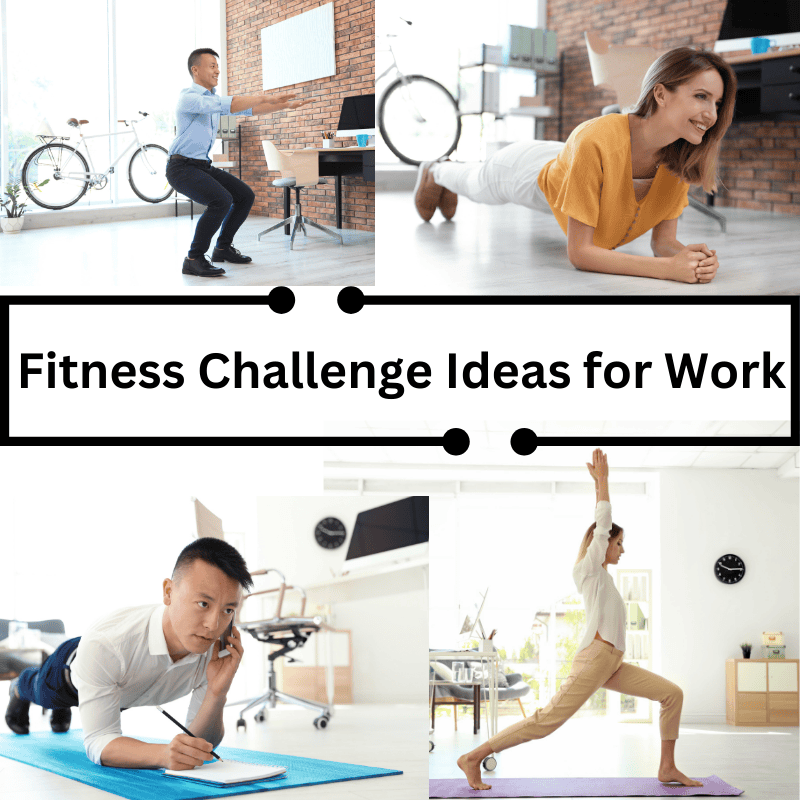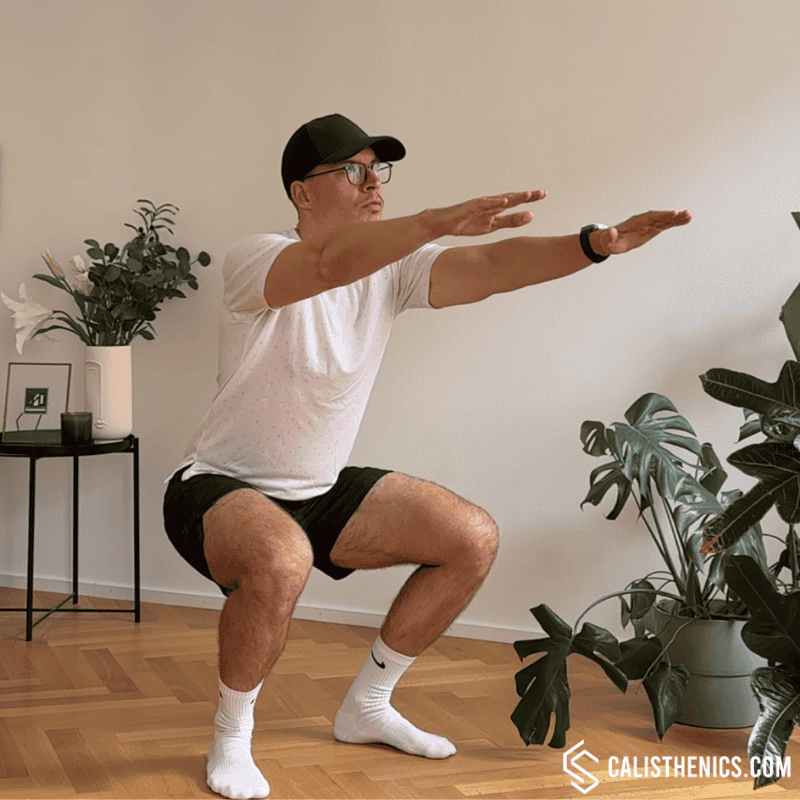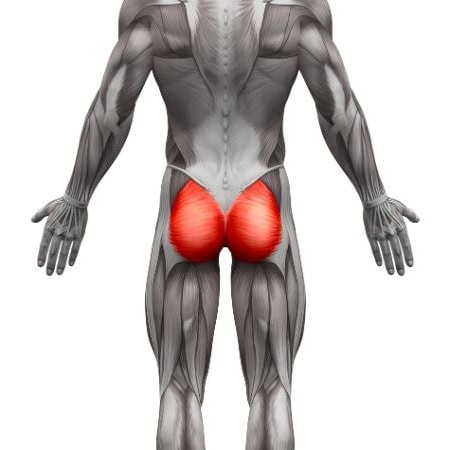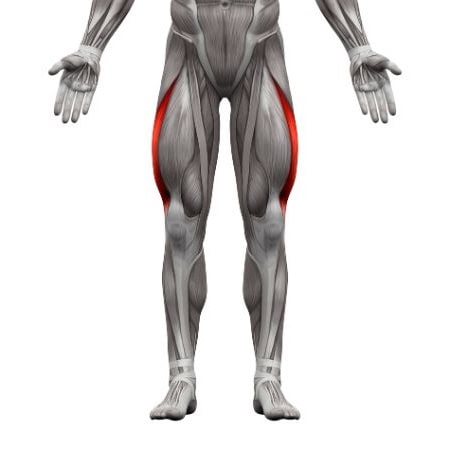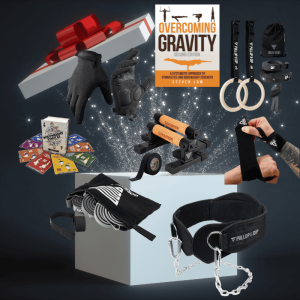I love the idea of bringing isometric exercises into the workplace! Imagine a fun, friendly competition where everyone’s cheering each other on to see who can hold a plank or a wall sit the longest. It’s a lighthearted way to bring some fitness (and a little excitement) into the day—and it does wonders for building a stronger sense of community at work.
If you are new to bodyweight training make sure you check out our intro about calisthenics and the ▶️ free 4-week workout plan for complete beginners.
Isometric Fitness Challenges are the Best for a Workplace
Incorporating isometric challenges at work isn’t just about the exercise itself; it’s also a way for employees to see each other in a new light. There’s something about watching a colleague shake, grimace, and grit through a wall sit that brings out everyone’s “fun side.” And because these exercises don’t require any special setup or gym clothes, anyone can jump in. A plank hold or wall sit takes up barely any space, and they’re challenging for every fitness level, which makes them perfect for a group competition.
Isometric exercises also bring real physical benefits, especially for people who spend hours sitting. A study from the American Journal of Physiology found that brief, simple muscle contractions throughout the day (even without full-range movements) can improve circulation and reduce some of the negative effects of prolonged sitting. So, while everyone’s focused on outlasting each other in a plank hold, they’re also strengthening their core, improving stability, and counteracting some of the physical stiffness that builds up over a sedentary workday.
And the best part? Challenges like these can create a more cohesive team. A study in The Journal of Occupational Health Psychology shows that group activities and friendly competitions can improve workplace cohesion and morale. So, not only is everyone getting a workout, but they’re also bonding in a way that goes beyond the usual office interactions. It’s these shared moments, filled with a mix of encouragement, laughter, and a little competitive spirit, that can build stronger relationships among coworkers.
By the end of the month, you’ll have employees feeling stronger, moving better, and, perhaps most importantly, feeling a stronger connection to the team. It’s fun, it’s easy to join, and it brings a breath of fresh air to the workday—all while supporting physical health.
Challenging but Non-Sweaty Exercises for Every Fitness Level
When putting together exercises for a workplace fitness challenge, the goal is to choose moves that are not only effective but also comfortable and accessible for everyone. Office fitness can be a bit tricky because it needs to fit into a professional setting without making anyone feel awkward or out of place. That’s why, first and foremost, I focused on exercises that don’t put anyone in an uncomfortable position. These movements should feel natural, even in a workspace, and allow participants to engage without feeling self-conscious.
Safety is also key here, especially since we’re looking at exercises that can be done by people of all fitness levels. The ideal exercises will be ones that don’t require any high-level skills or mobility, so they’re safe and effective for both beginners and experienced fitness enthusiasts alike. It’s also essential that these moves are gentle enough for any work attire. We don’t want anyone worrying about their clothes shifting or restricting them, so the exercises should work in anything from casual to formal wear.
Another practical consideration is keeping it sweat-free. Since employees may want to jump into these challenges without needing a shower break afterward, these exercises are meant to offer a good muscle challenge without an intense cardio effect. And because we want this to be a truly inclusive challenge, no equipment should be required. That way, everyone can participate without needing to bring anything special from home.
Lastly, I’ve focused on exercises that don’t require touching the ground. Not only does this make it more comfortable for participants who might be in more formal clothes, but it also keeps the challenge convenient for any setting in the workplace. By meeting all these criteria, these exercises should create a fun and engaging experience that everyone can enjoy without feeling out of place or uncomfortable.
Example Exercises for the Fitness Challenge
Here’s a quick breakdown of each exercise to get everyone started on the challenge:
- Batwing Wall Plank: Stand facing a wall with your feet about 2-3 feet away from it. Place your elbows against the wall at shoulder height, keeping them bent at a 90-degree angle. Press into the wall with your elbows, as if you’re trying to push your body backward without moving your feet. Engage your core and shoulders to maintain the push, feeling the burn in your upper back and arms. This is a great way to work those muscles without needing to get on the floor!
- Squat Hold: For this one, lower yourself into a squat position as if you’re about to sit down in an invisible chair, aiming to get your thighs parallel to the ground. Keep your weight in your heels, chest up, and core engaged as you hold this position. Your legs will feel the burn, and you’ll be building some serious lower-body strength. It’s simple but surprisingly challenging, especially when you push to hold it for as long as possible.
Tips
-
Maintain an Upright Posture: Keep your chest up and back straight during the entire hold. Avoid letting your lower back round, which can put strain on the spine.
-
Knee and Toe Alignment: Ensure that your knees track over your toes and do not collapse inward. Your knees should be at a 90-degree angle or slightly less.
-
Keep Your Heels Down: Ensure that your weight is distributed evenly across your feet, with your heels pressed firmly into the ground. You should be able to wiggle your toes slightly.
-
Engage Your Core: Tighten your abdominal muscles to help stabilize your lower back and maintain proper form throughout the hold.
-
Breathe Consistently: Don’t hold your breath! Breathe deeply and consistently to stay relaxed and focused.
- Seated Leg Extension Hold: Sit up straight in a chair with your feet flat on the floor. Extend one leg straight out in front of you until it’s parallel to the ground, keeping your toes flexed toward you. Hold this position, engaging your quadriceps to keep your leg lifted. Switch to the other leg after each hold. This exercise is great for your quads and can be done easily from any chair.
- Calf Raise Hold: Stand with your feet hip-width apart and rise onto the balls of your feet, lifting your heels as high as you can. Hold this position to target your calf muscles, keeping your balance and stability in check. If you need extra support, lightly place your hands on a desk or wall. This hold gives your calves a serious workout and is simple to do without much movement or space.
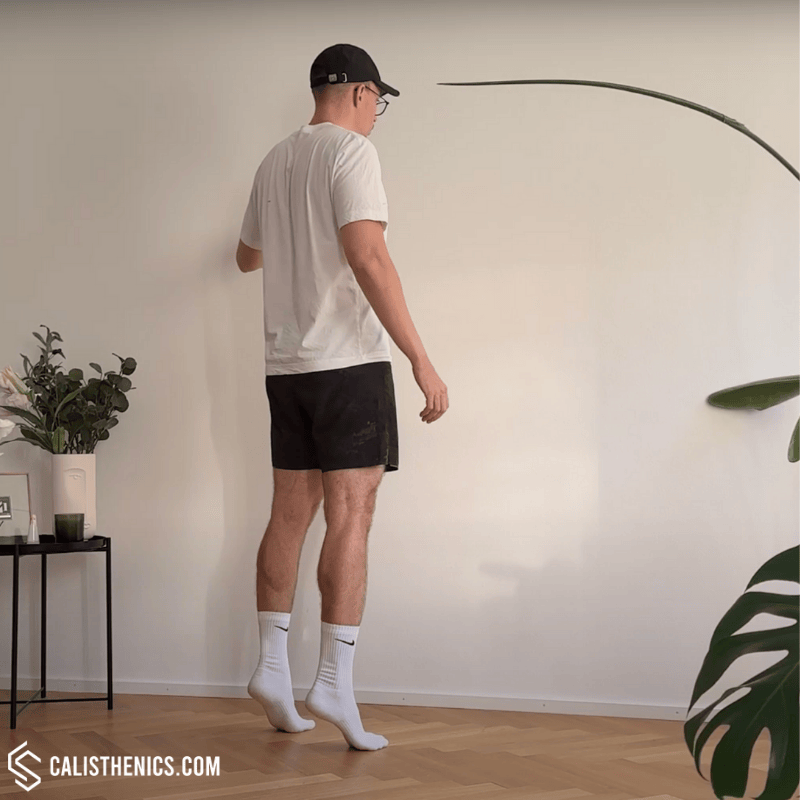
- T-Stance Hold: Start by standing on one leg and extending the other leg straight back while reaching your arms forward, creating a “T” shape with your body. Try to get your body as parallel to the ground as possible, engaging your core to stay stable. To make it more challenging, close your eyes, which adds an element of balance difficulty. This exercise works your core, glutes, and lower back, all while testing your balance and focus.
Each of these isometric exercises is designed to bring strength and stability benefits to different muscle groups without requiring a lot of space or equipment. Enjoy the challenge, and see who can hold each position the longest!
How to Execute These Challenges in a Fun Way
When I came up with these challenges, my main goal was to make them fun, practical, and totally doable in a work setting. I wanted each activity to help build strength, balance, and endurance but in a way that anyone can jump into, no matter their fitness level.
Isometric holds seemed perfect for this—they’re great for muscle endurance, they don’t make you sweat, and there’s no equipment needed. Plus, they’re easy to do in regular work clothes without needing much space, so they fit right into a busy day at the office.
I also thought about the social side, knowing a bit of friendly competition and team goals can really keep everyone motivated and bring people together. With simple progressions and the option to work as a group, these challenges are designed to be something we can all look forward to—a little burst of movement and connection during the workday.
1. The “Static Strength Circuit” Challenge
• How It Works: Pick a different isometric hold for each day of the week. For example, Monday could be a wall sit hold, Tuesday a batwing wall plank, Wednesday a T-stance, and so on. Each day, challenge participants to hold the position as long as they can and record their times.
• Goal: By the end of the week, see if you can beat your original time in each position by at least 20% or have a “record-holder” for each day.
• Why It Works: This keeps things fresh by switching up the focus each day and encourages everyone to improve their endurance bit by bit.
2. “Team Average Hold Time” Challenge
• How It Works: Split participants into teams. Each team member performs a static hold of the same exercise each day (like a wall sit or batwing wall plank), recording how long they can hold it. Add up the times of all team members and find the average for the team.
• Goal: Each day, try to increase the team’s average hold time. At the end of the challenge (say, over one or two weeks), the team with the highest average wins!
• Why It Works: This is great for teamwork and allows individuals to contribute based on their current fitness level, all while encouraging group improvement.
3. “Three-Minute Balance Builder” Challenge
• How It Works: This challenge is all about T-stance holds, with an optional eye-closing element. Each day, aim to accumulate a total of three minutes in the T-stance (90 seconds on each leg) without breaking form. You don’t need to do it all at once—break it up into intervals if you need to.
• Goal: The goal is to build up to holding each leg for 90 seconds unbroken by the end of the challenge. This one’s great for building balance, coordination, and focus.
• Why It Works: This challenge takes minimal time, yet it’s a real test of stability and core strength, and it encourages steady progress toward balance mastery.
4. “Daily Core & Leg Burn” Challenge
• How It Works: Each day, participants alternate between holding a squat hold and a seated leg extension hold, aiming to reach a cumulative time of two minutes per hold by the end of the day. For instance, participants might hold a squat for 30 seconds in the morning, then 30 more seconds at lunch, and so on.
• Goal: The challenge is to complete the two minutes of each hold daily and gradually extend individual hold times throughout the week until they can hit the two minutes in just one go.
• Why It Works: Breaking it up makes it approachable, and the gradual increase encourages strength gains without overwhelming anyone, even beginners.
5. “Wall Plank Marathon” Challenge
• How It Works: Every participant starts with a daily wall plank hold (batwing position), with a goal to increase their hold time by 5 seconds each day. Track everyone’s progress on a challenge board to see who’s leading or who has reached the longest cumulative time over a week or month.
• Goal: By the end of the challenge, participants aim to hold the wall plank for up to a minute or more. The person with the longest cumulative time at the end wins.
• Why It Works: This adds a slight competitive edge while keeping the challenge accessible and manageable for everyone—plus, it builds upper body and core endurance in a low-impact way.
Each of these challenges keeps things straightforward and adaptable to all fitness levels, while adding variety and fun. The camaraderie, gentle competitiveness, and steady progress make them perfect for an engaging, inclusive workplace fitness experience.
Conclusion
These fitness challenges are more than just a way to get moving at work—they’re a chance to bring everyone together, have a little fun, and build strength in ways that fit easily into the day. By focusing on isometric exercises that are simple yet effective, everyone can participate without worrying about getting sweaty or needing special gear. It’s a great way to break up the workday, give our muscles some much-needed activity, and work on stability and endurance, all while cheering each other on and maybe sparking a bit of friendly competition.
Whether you’re aiming to beat your own hold time or trying to help your team win the “team average” challenge, these activities offer something valuable for everyone. They’re designed to be quick, accessible, and enjoyable, with just the right amount of challenge to make you feel accomplished by the end of the day. So, if you’re looking to bring more movement into the workday and build a stronger sense of community, give these challenges a try—they might just become the highlight of everyone’s day!
Resources:
1. University of Illinois Study on Brief Diversions and Focus: This study found that short breaks can significantly improve attention and performance on prolonged tasks. (Science Daily)
2. The Lancet Psychiatry Article on Physical Activity and Mental Health: This article discusses the positive impact of regular physical activity on mental health, highlighting its role in reducing symptoms of depression and anxiety. (KCL Pure)
3. American Journal of Physiology Study on Muscle Contractions and Circulation: This research indicates that brief, simple muscle contractions throughout the day can improve circulation and mitigate some negative effects of prolonged sitting. (American Psychological Association)
4. Journal of Occupational Health Psychology on Group Activities and Workplace Cohesion: This study explores how group activities and friendly competitions can enhance workplace cohesion and morale. (American Psychological Association)

